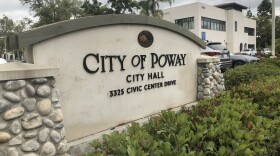


The greater sage grouse is a peculiar and distinctly Western bird. It's about the size of a chicken and about as adaptable as the dodo bird, which is to say it's not very adaptable at all — at least not in a human-driven time scale.
In biological terms, the greater sage grouse is perfectly adapted for its habitat: the rolling hills of knee-high silver scrub that's sometimes called the sagebrush sea. It's the oft-forgotten parts of the fast-changing West; The Big Empty, as settlers used to call it.
Today though, it's better known for its other uses: big energy, big mining and big agriculture, which has caused a big problem for the bird.
There are about 400,000 greater sage grouse left on the landscape, spread across 11 Western states, from California to North Dakota. That's a fraction of what their numbers were just a century ago, when homesteaders described them as blackening out the skies.
Human hunting, predators, drought and wildfire have all whittled their numbers down, but it's human development that's the real culprit. A recent study by Pew Charitable Trusts found that greater sage grouse numbers decreased by 56 percent from 2007 to 2013.
Because of that decline, the U.S. Fish and Wildlife Service has been tasked with determining whether or not the greater sage grouse needs protections under the Endangered Species Act by the end of the month, a deadline that's led to hand-wringing across the West.
"When they listed the spotted owl in the Northwest, it literally devastated the counties and communities that their living was on timber," says Joel Bousman, a rancher and county commissioner in west central Wyoming. "Our fear here is that it would have a similar impact on oil and gas, grazing, livestock grazing."
The red tape and restrictions to development that would come with a listing, he says, would turn small rural hubs like the town of Pinedale into ghost towns.
'A Mecca For Sage Grouse'
That fear is particularly strong in Bousman's Sublette County. The county is about the size of Delaware with about one percent of the people — 10,000 give or take, some of whom proudly boast that they live in the only county in America that doesn't have a stoplight. And it's at the heart of the greater sage grouse issue.
Sublette County's economy is 95 percent based on oil and gas, Bousman says. Two of the top 10 most productive gas fields in the country are here in the rolling hills south of the towering snow-covered peaks of the Wind River Range. Those hills just also happen to be the best place in the world to find greater sage grouse.
Wyoming Game and Fish biologist Dean Clause calls Sublette County "a mecca for sage grouse" in no small part because of the lack of people.
"They need very large, vast expanses of sage brush that are relatively quiet and undisturbed," Clause says. And that's becoming an increasingly scarce commodity in much of the West.
"In this day and age, with more people and more and more activity on the landscape, to try to minimize development and disturbance, it's not always feasible," he says.
That's partially due to the fact that for a greater sage grouse, a disturbance can be almost anything that fragments the landscape: roads, transmission lines, wind turbines, cattle fences, subdivisions, oil pads. Odds are if a human built it, sage grouse don't like it.
That's troubling to industry and developers of the land like Paul Ulrich, a Pinedale native who works for Jonah Energy, an oil and gas company.
"A listing would be devastating to our operations," he says.
Jonah Energy has more than 1,600 producing wells in Sublette County, most of them dotting a broad mesa that's prime sage grouse habitat.
"[A listing] would add significant timelines to every aspect of what we do, from drilling to completions, to reclamation, to up-front staking, where we go, where we can't," Ulrich says. "And the issue isn't just oil and gas. It's ranchers, recreationalists, conservation groups. The impact across the board is significant."
A widely-accepted study estimates that $5.6 billion of economic output would be lost if the bird was listed as endangered, which has spurred a lot of people into action.
The Sage Grouse Conservation Effort
On a sunny Friday morning earlier this summer, men and women representing the various parts of Sublette County gathered at the local Bureau of Land Management field office, walking past a stand of sage grouse-adorned pamphlets on the way in. There are representatives from the BLM, the U.S. Forest Service, Wyoming Game and Fish, a sportsmen's group, a consulting firm, an oil and gas company, a conservation group and a local cattle association present.
They meet like this at least once a month to discuss the greater sage grouse and what they can do here, on a local level, to protect its habitat and limit their disturbances to it. None of them want to see the bird listed as an endangered species later this month.
"Certainly, the Endangered Species Act is a huge hammer that's motivated a lot of people to come to the table," says Tom Christiansen, Wyoming's Sage Grouse Program Coordinator.
Christiansen is sitting in on this working group meeting this day, as he does at other local working groups in other parts of the state. Similar local efforts are happening in Montana, Idaho, Utah, Nevada and the other six states that are home to the bird.
The shared hope is that by putting sufficient protections in place for the greater sage grouse, the U.S. Fish and Wildlife Service won't list the bird as endangered. And for some, that means compromises and sacrifices up front.
The energy companies here in Sublette County say they've spent millions of dollars to fund sage grouse research and in off-site mitigation, a practice that preserves other sage grouse habitat from being developed. Jonah Energy has committed to holding off on the development of a planned 3,500-well operation in a gas-rich field at the southern end of the county because biologists recently determined that it's important winter habitat for the bird.
The state of Wyoming says it has spent nearly $10 million on protecting greater sage grouse in recent years.
Just last week, the U.S. Department of Agriculture promised more than $200 million for sage grouse conservation efforts over the next three years, with the hopes of almost doubling the current amount of protected habitat. That's on top of about $400 million that they have already spent since 2010.
"This sage grouse conservation effort on a range-wide scale is the largest conservation effort ever undertaken for a single species, period," Christiansen says.
Not everyone agrees with that characterization though. Some environmental groups, like the Western Watersheds Project, argue that it could be the largest conservation effort ever undertaken, if it works. And they're not convinced that it will.
"You can sum up all of the plans to protect sage grouse that have occurred over the last year and a half as 'planning to plan,' " says Travis Bruner, executive director of Western Watersheds.
And even those plans, Bruner says, allow for too much development on the landscape, which the science clearly says is bad for the bird. That's why he feels it must be listed under the Endangered Species Act.
"The Endangered Species Act provides us an opportunity to save the greater sage grouse now, before it's too late," Bruner says. "If we wait until we're down to some ridiculously low number of birds to try to reverse these human impacts it will be much too late."
And by saving the sage grouse, they can save hundreds of other species, too. The sage grouse is what's called an indicator species. It's the canary in the coal mine for the greater sagebrush ecosystem, which scientists say is home to more than 350 species.
What's Good For The Bird Is Good For The Herd
Not all conservation groups feel that a listing would be the most productive end though come Sept. 30. The Audubon Society, for one, is supporting the diverse collaborative efforts that are under way in various states to protect the bird because it sees the buy-in from all of the mixed interests as the most effective way to protect the sweeping sagebrush ecosystem, even though they're not perfect.
"Instead of having five federal employees responsible for 160 million acres of habitat, we have 11 states responsible for that habitat," says Brian Rutledge, Audubon's vice president and a Wyoming rancher.
More importantly, he says, you have the buy-in of people that work on the landscape, a buy-in that's not entirely driven by economics.
"People think of ranchers as the Cliven Bundy's of the world and it's not the case," Rutledge says. "I've had ranchers corner me to say that they need help because they wanted the guys that were abusing the cottonwood galleries south of them straightened out because their hummingbirds weren't getting to them anymore."
That sentiment is clear when you spend a few days with the people and ranchers who call Sublette County home.
"The land really grabs you," says Albert Sommers, a local rancher. "It just really gets ahold of you."
Sommers is a Republican lawmaker in the state legislature and an electrical engineer by training. He's been back on the family ranch since after college, but on most days you'd confuse him for a wildlife biologist, if it wasn't for his baseball cap, which proudly reads: Sommers Herefords: Grizzly Tested, Wolf Approved.
That's because Sommers spends many of his days bent over in the knee-high sage brush measuring the height and distance between bunch grass and seeing how much of it has been eaten by his cattle. Bunch grass is important for sage grouse, too, and he wants to make sure that his cattle aren't overrunning the hillside because that would be bad for the bird and bad for his cattle operation down the road. It's an idea best summarized by the phrase "What's good for the bird is good for the herd."
"What it really is if you take care of the land, it'll take care of you," Sommers says. "In this industry we're in, we're multi-generational, we are sustainability. We can't abuse the landscape we're in."
And, he says, the sage grouse issue has made that abundantly clear.
The West is changing, Sommers says. More ranches are going under. More subdivisions are popping up. And, he thinks, a listing of the bird would speed that up because it would make ranching operations like his economically unfeasible. That, he says, would be the worst thing for the bird. It would make the large tracts of land that see little human impact — like his — open to development.
"If we can preserve and conserve these working landscapes, these economies of the West," Sommers says, about ranches, energy development and recreation, "we can preserve and conserve the ability for a lot of these native species to exist out here."
In other words, Sublette County is never going to be a national park. It's going to have humans on it. It's going to have development. And for a bird that needs wide-open spaces like sage grouse, he'd argue that it's better to have that development be ranches like his instead of 20-acre subdivided plots.
For Sommers, the debate over the greater sage grouse is much larger than a bird. He's trying to preserve the way of life that his family started three generations ago. "If we fail to do that, and this land just becomes home sites for the next generation of American suburbanites, we'll lose the custom and culture of the West and we'll lose the wildlife of the West," he says.
And he says he won't let that happen without a fight.
Copyright 2015 NPR. To see more, visit http://www.npr.org/.






